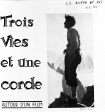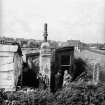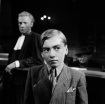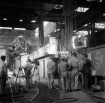Symphonie Paysanne
| 片名: | Symphonie Paysanne |
|---|---|
| 其它片名: | 农夫交响曲/Peasant Symphony |
| 导演: | Henri Storck |
| 制片人: | Joseph Van Bladel |
| 摄影: | Henri Storck, François Rents, Maurice Delattre, Charles Abel |
| 声音: | José Lebrun |
| 剪辑: | Henri Storck |
| 音乐: | Pierre Moulaert |
| 片长: | 115分钟 |
| 年份: | 1944年 |
| 类型: | 纪录片 |
| 国别: | 比利时 |
| 语言: | |
| 格式: | 35毫米/黑白 |
| 制作机构: | CEP |
影片概述 . . . . . .
《Misère au Borinage accompanied the rebellion and distress of the
working class at a determining moment in its struggles. Symphonie
paysanne was filmed during years when historical attention was
seriously required elsewhere and when the time for peasant revolt was
past. This double obliteration, of date and attention, diminished the
perceived mastery of this film. This was before the peasants'
incomprehension in the face of European directives and their
demonstrations, before the impact of ecology, just at a time of
defiance, that of Giono's disturbing and vaguely Pétainist call for a
return to the land. This configuration, which was so completely
contrary to Henri Storck's deep and constant social generosity,
prevented the film from taking its proper place. Film historians and
film lovers, however, are not to be fooled. It is time to say that
Symphonie paysanne is an important and admirable film. This film is one
in a line of ethnological films by Henri Storck: the sea (with the
whole cycle of films on Ostend), the conditions of the working classes,
the conditions of the peasants, the recording of festivities and
carnivals, the importance of art and artists; this is the filmmaker as
witness of his times. It is a film in four seasons, with a fifth part,
Noces paysannes, which is, in a way, the metaphor for the unfolding of
the cycle wherein man takes responsibility for relationships of play,
love and constant work that regulate the progression of the world.
All the shots in this film are inspired: the earth and the sky, the
rows of trees, the animals (in all the history of cinema there have
never been more beautiful cows or horses than these), haymaking,
harvesting and above all, the terrible pulling up of potatoes or
beetroots that remind us, no pun intended, of the Damned of the Earth.
Yet everything is bathed in harmony. There is nothing idyllic about it for the images of the unjust struggle with the elements are very present. But there is an additional Virgil-like contribution, with the march of the world symbolized by the parallel march of the human, vegetable and animal realms.
"It so happened that in 1941, Camille Goemans was employed in a modest
capacity by the Department of Food and Agriculture. He recommended the
project to management and in the end, the filmmaker had the means to
make the film he had been thinking about for so long. The filming lasted three years and thus managed to embrace all the seasons, without which, it would have lost its very reason for being... In Flanders, the farmer at whose place Henri Storck set up his team, was arrested by the Germans and shot dead. In Walloon, the farmer was assassinated by the Rexists. These were the final dramas in this adventure involving a team of filmmakers, but the film goes beyond the time when it was made and celebrates a timeless forbearance."
Jean Queval, Henri Storck ou la traversée du cinéma, 1976
"Henri Storck's masterpiece in the field of sociological testimony is
probably the long documentary (too often ignored by film historians)
devoted to the life of Flemish and Walloon peasants in the Brabant
region. The film is constructed as a grand, slow nature poem, where the
life and death of men, animals and plants are so many identical,
equivalent lyrical themes. And yet, it is man and his ceaseless labour
that are the film's centre of gravity
Luc de Heusch, Cinéma et sciences sociales, 1962, Unesco.
伯利纳奇的苦难》纪录了工人阶级的苦难与反抗直到它斗争的决定时刻。而《农夫交响曲》拍摄的那个年代,雅克雷农民起义已经结束,历史的焦点已大幅度转向了别处。这个在时间与时代焦点上的双重泯灭削弱了本片本应闪耀的光辉。它发生在农民对欧洲公约产生抵触情绪和生态学产生影响之前,Giono发出了贝当主义回归土地的号召。这一切都恰好处在人心惶惶的怀疑时期,这与斯托克一贯深切的社会关怀背道而驰。在这种形势下,本片在当时并没有获得应有的重视。然而,史学家和电影爱好者是不会被蒙蔽的。现在我们可以说《农夫交响曲》是一部伟大而令人敬佩的电影。本片可被纳入亨利斯托克的民族志研究轨道:北海(奥斯坦德系列),工人阶级的困境,农民的生活状态,民俗节日的纪录,艺术家和他们的艺术,这些都是导演对于他所处那个时代的见证。
影片的前四部分分别为“春”,“夏”,“秋”,“冬”,加上第五个部分“乡村婚礼”,象征着生命的轮回。在轮回中,人类要承担起对玩乐和感情的责任,以及支配世界发展的永恒劳作。
影片的每一个镜头都富有灵性:天空与大地,一排排树木,成群的动物(在电影史上从未见过如此美丽的牛马),耕作(晒麦草、收割,特别是拔土豆或者甜菜的恐怖场面让人们想起该死的土地佬这种邪恶的字眼)一切都沉浸在和谐中,但这种和谐绝不是田园诗般的,因为反抗不公的斗争无处不在。此外,影片还体现出一个维吉尔式的贡献,即用人类、动物、植物三个体系并列来象征整个世界的运转。
“事情发生在1941年,Camille Goemans在国家农业食品部门(CN.A.A)从事一个小职务。他向上级提交了这个拍摄项目,于是导演终于有了必要的物质支持帮助他拍成这部酝酿已久的影片。前期拍摄花了整整三年,终于完整纪录下了每一个季节,因为缺少其中任何一个,影片都将失去存在的理由。在佛兰德,斯托克剧组扎驻在一个农民家,而那个农民最后被德国人逮捕并枪杀。在瓦隆,另一个农民则被雷克斯特主义者(二十世纪上半页比利时的法西斯政党)暗杀。这是发生在这次拍摄过程中最极端的悲剧,然而影片的拍摄本身已经超越了时代,它对永恒的坚忍进行了赞颂。”
Jean Queval,《穿越电影的亨利斯托克》 , 1976年
“亨利斯托克在社会学实证领域最杰出的作品大概就是他那部长篇纪录片(通常被电影史学家所忽视),拍摄在布拉邦地区的佛拉芒和瓦隆农民。影片的构建如同一首宏大而缓慢的自然诗歌,人类的生与死,动物与植物组成了如此相象对应的抒情性主题。然而人类和他无休止的劳作才是影片的重心所在。
Luc de Heusch, 《电影与社会学》, 1962年, 联合国教科文组织.
working class at a determining moment in its struggles. Symphonie
paysanne was filmed during years when historical attention was
seriously required elsewhere and when the time for peasant revolt was
past. This double obliteration, of date and attention, diminished the
perceived mastery of this film. This was before the peasants'
incomprehension in the face of European directives and their
demonstrations, before the impact of ecology, just at a time of
defiance, that of Giono's disturbing and vaguely Pétainist call for a
return to the land. This configuration, which was so completely
contrary to Henri Storck's deep and constant social generosity,
prevented the film from taking its proper place. Film historians and
film lovers, however, are not to be fooled. It is time to say that
Symphonie paysanne is an important and admirable film. This film is one
in a line of ethnological films by Henri Storck: the sea (with the
whole cycle of films on Ostend), the conditions of the working classes,
the conditions of the peasants, the recording of festivities and
carnivals, the importance of art and artists; this is the filmmaker as
witness of his times. It is a film in four seasons, with a fifth part,
Noces paysannes, which is, in a way, the metaphor for the unfolding of
the cycle wherein man takes responsibility for relationships of play,
love and constant work that regulate the progression of the world.
All the shots in this film are inspired: the earth and the sky, the
rows of trees, the animals (in all the history of cinema there have
never been more beautiful cows or horses than these), haymaking,
harvesting and above all, the terrible pulling up of potatoes or
beetroots that remind us, no pun intended, of the Damned of the Earth.
Yet everything is bathed in harmony. There is nothing idyllic about it for the images of the unjust struggle with the elements are very present. But there is an additional Virgil-like contribution, with the march of the world symbolized by the parallel march of the human, vegetable and animal realms.
"It so happened that in 1941, Camille Goemans was employed in a modest
capacity by the Department of Food and Agriculture. He recommended the
project to management and in the end, the filmmaker had the means to
make the film he had been thinking about for so long. The filming lasted three years and thus managed to embrace all the seasons, without which, it would have lost its very reason for being... In Flanders, the farmer at whose place Henri Storck set up his team, was arrested by the Germans and shot dead. In Walloon, the farmer was assassinated by the Rexists. These were the final dramas in this adventure involving a team of filmmakers, but the film goes beyond the time when it was made and celebrates a timeless forbearance."
Jean Queval, Henri Storck ou la traversée du cinéma, 1976
"Henri Storck's masterpiece in the field of sociological testimony is
probably the long documentary (too often ignored by film historians)
devoted to the life of Flemish and Walloon peasants in the Brabant
region. The film is constructed as a grand, slow nature poem, where the
life and death of men, animals and plants are so many identical,
equivalent lyrical themes. And yet, it is man and his ceaseless labour
that are the film's centre of gravity
Luc de Heusch, Cinéma et sciences sociales, 1962, Unesco.
伯利纳奇的苦难》纪录了工人阶级的苦难与反抗直到它斗争的决定时刻。而《农夫交响曲》拍摄的那个年代,雅克雷农民起义已经结束,历史的焦点已大幅度转向了别处。这个在时间与时代焦点上的双重泯灭削弱了本片本应闪耀的光辉。它发生在农民对欧洲公约产生抵触情绪和生态学产生影响之前,Giono发出了贝当主义回归土地的号召。这一切都恰好处在人心惶惶的怀疑时期,这与斯托克一贯深切的社会关怀背道而驰。在这种形势下,本片在当时并没有获得应有的重视。然而,史学家和电影爱好者是不会被蒙蔽的。现在我们可以说《农夫交响曲》是一部伟大而令人敬佩的电影。本片可被纳入亨利斯托克的民族志研究轨道:北海(奥斯坦德系列),工人阶级的困境,农民的生活状态,民俗节日的纪录,艺术家和他们的艺术,这些都是导演对于他所处那个时代的见证。
影片的前四部分分别为“春”,“夏”,“秋”,“冬”,加上第五个部分“乡村婚礼”,象征着生命的轮回。在轮回中,人类要承担起对玩乐和感情的责任,以及支配世界发展的永恒劳作。
影片的每一个镜头都富有灵性:天空与大地,一排排树木,成群的动物(在电影史上从未见过如此美丽的牛马),耕作(晒麦草、收割,特别是拔土豆或者甜菜的恐怖场面让人们想起该死的土地佬这种邪恶的字眼)一切都沉浸在和谐中,但这种和谐绝不是田园诗般的,因为反抗不公的斗争无处不在。此外,影片还体现出一个维吉尔式的贡献,即用人类、动物、植物三个体系并列来象征整个世界的运转。
“事情发生在1941年,Camille Goemans在国家农业食品部门(CN.A.A)从事一个小职务。他向上级提交了这个拍摄项目,于是导演终于有了必要的物质支持帮助他拍成这部酝酿已久的影片。前期拍摄花了整整三年,终于完整纪录下了每一个季节,因为缺少其中任何一个,影片都将失去存在的理由。在佛兰德,斯托克剧组扎驻在一个农民家,而那个农民最后被德国人逮捕并枪杀。在瓦隆,另一个农民则被雷克斯特主义者(二十世纪上半页比利时的法西斯政党)暗杀。这是发生在这次拍摄过程中最极端的悲剧,然而影片的拍摄本身已经超越了时代,它对永恒的坚忍进行了赞颂。”
Jean Queval,《穿越电影的亨利斯托克》 , 1976年
“亨利斯托克在社会学实证领域最杰出的作品大概就是他那部长篇纪录片(通常被电影史学家所忽视),拍摄在布拉邦地区的佛拉芒和瓦隆农民。影片的构建如同一首宏大而缓慢的自然诗歌,人类的生与死,动物与植物组成了如此相象对应的抒情性主题。然而人类和他无休止的劳作才是影片的重心所在。
Luc de Heusch, 《电影与社会学》, 1962年, 联合国教科文组织.
导演阐述 . . . . . .
“拍摄本片的想法要追溯到1936年。我一直都觉得应该让城市居民看到农民们的辛苦劳作,就像我之前拍摄伯利纳奇的矿工以及奥斯坦德的渔民。我热爱这些卑微甚至是被蔑视的农民,因为他们是在与真正的困难进行着斗争,他们的生活与大自然四季的节奏合拍。他们不和人类的愚蠢与邪恶较劲,他们需要面对的是气候的反复无常、霜冻、干旱、动植物的疾病等等,而这份努力的结果便是最高奖赏:他们创造着生活。"The idea for this film goes back to 1936. I had always thought that city-dwellers should be shown the hard work done by peasants in the
same way that I showed that of the miners in Borinage and that of the
Ostend fishermen. I like these little-known oft-scorned peasants, because they are people who fight against real difficulties, who are in tune with the rhythm of the seasons. They do not struggle against human stupidity or badness, but against the whims of the weather, frost, drought, plant and animal diseases... and the result of this effort is the supreme reward: they create life."
Henri Storck, 1946
same way that I showed that of the miners in Borinage and that of the
Ostend fishermen. I like these little-known oft-scorned peasants, because they are people who fight against real difficulties, who are in tune with the rhythm of the seasons. They do not struggle against human stupidity or badness, but against the whims of the weather, frost, drought, plant and animal diseases... and the result of this effort is the supreme reward: they create life."
Henri Storck, 1946
获得奖项 . . . . . .
评论列表(0) . . . . . . ( 发表新评论 ) ( 更多评论 )
幕后花絮 . . . . . . (上传花絮) (展开所有)
影片图集 . . . . . . (更多/我要上传)
相关视频 . . . . . . (更多/我要分享)
对本影片资料作出贡献的会员 . . . . . .
4444(创建者)
Henri Storck导演的其它影片 . . . . . .
相关资讯 . . . . . .
- CDFF2009 DAY5 亨利·斯托克回顾展精彩继续 2009-05-28
















